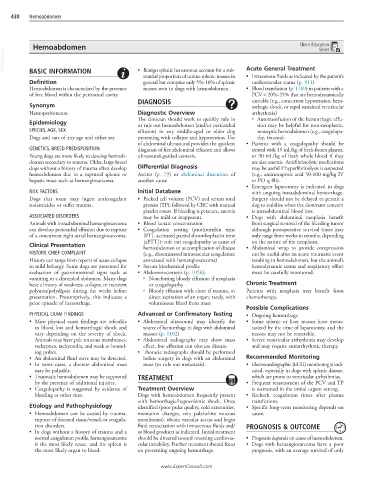Page 885 - Cote clinical veterinary advisor dogs and cats 4th
P. 885
430 Hemoabdomen
Hemoabdomen Client Education
Sheet
VetBooks.ir Acute General Treatment
• Benign splenic hematomas account for a sub-
BASIC INFORMATION
stantial proportion of canine splenic masses in • Intravenous fluids as indicated by the patient’s
Definition general but comprise only 5%-10% of splenic cardiovascular status (p. 911)
Hemoabdomen is characterized by the presence masses seen in dogs with hemoabdomen. • Blood transfusion (p. 1169) in patients with a
of free blood within the peritoneal cavity. PCV < 20%-25% that are hemodynamically
DIAGNOSIS unstable (e.g., concurrent hypotension, hem-
Synonym orrhagic shock, or rapid sustained ventricular
Hemoperitoneum Diagnostic Overview arrhythmia)
The clinician should work to quickly rule in ○ Autotransfusion of the hemorrhagic effu-
Epidemiology or rule out hemoabdomen (and/or pericardial sion may be helpful for non-neoplastic,
SPECIES, AGE, SEX effusion) in any middle-aged or older dog nonseptic hemoabdomen (e.g., coagulopa-
Dogs and cats of any age and either sex presenting with collapse and hypotension. Use thy, trauma).
of abdominal ultrasound provides the quickest • Patients with a coagulopathy should be
GENETICS, BREED PREDISPOSITION diagnosis of free abdominal effusion and allows treated with 15 mL/kg of fresh-frozen plasma,
Young dogs are more likely to develop hemoab- ultrasound-guided centesis. or 30 mL/kg of fresh whole blood if they
domen secondary to trauma. Older, large-breed are also anemic. Antifibrinolytic medications
dogs without a history of trauma often develop Differential Diagnosis may be useful if hyperfibrinolysis is suspected
hemoabdomen due to a ruptured splenic or Ascites (p. 79) or abdominal distention of (e.g., aminocaproic acid 50-100 mg/kg IV
hepatic mass such as hemangiosarcoma. another cause or PO q 8h).
• Emergent laparotomy is indicated in dogs
RISK FACTORS Initial Database with ongoing intraabdominal hemorrhage.
Dogs that roam may ingest anticoagulant • Packed cell volume (PCV) and serum total Surgery should not be delayed to permit a
rodenticides or suffer trauma. protein (TP); followed by CBC with manual dog to stabilize when the dominant concern
platelet count. If bleeding is peracute, anemia is intraabdominal blood loss.
ASSOCIATED DISORDERS may be mild or inapparent. • Dogs with abdominal neoplasia benefit
Animals with intraabdominal hemangiosarcoma • Blood lactate concentration from surgical removal of the bleeding tumor
can develop pericardial effusion due to rupture • Coagulation testing (prothrombin time although postoperative survival times may
of a concurrent right atrial hemangiosarcoma. [PT], activated partial thromboplastin time only range from weeks to months, depending
[aPTT]): rule out coagulopathy as cause of on the nature of the neoplasm.
Clinical Presentation hemoabdomen or as complication of disease • Abdominal wrap to provide compression
HISTORY, CHIEF COMPLAINT (e.g., disseminated intravascular coagulation can be useful after an acute traumatic event
History can range from reports of acute collapse associated with hemangiosarcoma) resulting in hemoabdomen, but the animal’s
to mild lethargy. Some dogs are presented for • Serum biochemical profile hemodynamic status and respiratory effort
evaluation of gastrointestinal signs such as • Abdominocentesis (p. 1056): must be carefully monitored.
vomiting or a distended abdomen. Many dogs ○ Nonclotting bloody effusion: if neoplasia
have a history of weakness, collapse, or transient or coagulopathy Chronic Treatment
polyuria/polydipsia during the weeks before ○ Bloody effusion with clots: if trauma, or Patients with neoplasia may benefit from
presentation. Presumptively, this indicates a direct aspiration of an organ; rarely, with chemotherapy.
prior episode of hemorrhage. voluminous bleed from mass
Possible Complications
PHYSICAL EXAM FINDINGS Advanced or Confirmatory Testing • Ongoing hemorrhage
• Most physical exam findings are referable • Abdominal ultrasound may identify the • Some splenic or liver masses have metas-
to blood loss and hemorrhagic shock and source of hemorrhage in dogs with abdominal tasized by the time of laparotomy, and the
vary depending on the severity of shock. masses (p. 1102) masses may not be resectable.
Animals may have pale mucous membranes, • Abdominal radiography may show mass • Severe ventricular arrhythmia may develop
tachypnea, tachycardia, and weak or bound- effect, but effusion can obscure disease. and may require antiarrhythmic therapy.
ing pulses. • Thoracic radiographs should be performed
• An abdominal fluid wave may be detected. before surgery in dogs with an abdominal Recommended Monitoring
• In some cases, a discrete abdominal mass mass (to rule out metastasis). • Electrocardiographic (ECG) monitoring is indi-
may be palpable. cated, especially in dogs with splenic disease,
• Traumatic hemoabdomen may be supported TREATMENT which are prone to ventricular arrhythmias.
by the presence of additional injuries. • Frequent reassessment of the PCV and TP
• Coagulopathy is suggested by evidence of Treatment Overview is warranted in the initial urgent setting.
bleeding at other sites. Dogs with hemoabdomen frequently present • Recheck coagulation times after plasma
with hemorrhagic/hypovolemic shock. Once transfusions.
Etiology and Pathophysiology identified (poor pulse quality, cold extremities, • Specific long-term monitoring depends on
• Hemoabdomen can be caused by trauma, mentation changes, very pale/white mucous cause.
rupture of diseased tissue/vessel, or coagula- membranes), obtain vascular access and begin
tion disorders. fluid resuscitation with intravenous fluids and/ PROGNOSIS & OUTCOME
• In dogs without a history of trauma and a or blood products as indicated. Initial treatment
normal coagulation profile, hemangiosarcoma should be directed toward reversing cardiovas- • Prognosis depends on cause of hemoabdomen.
is the most likely cause, and the spleen is cular instability. Further treatment should focus • Dogs with hemangiosarcoma have a poor
the most likely organ to bleed. on preventing ongoing hemorrhage. prognosis, with an average survival of only
www.ExpertConsult.com

